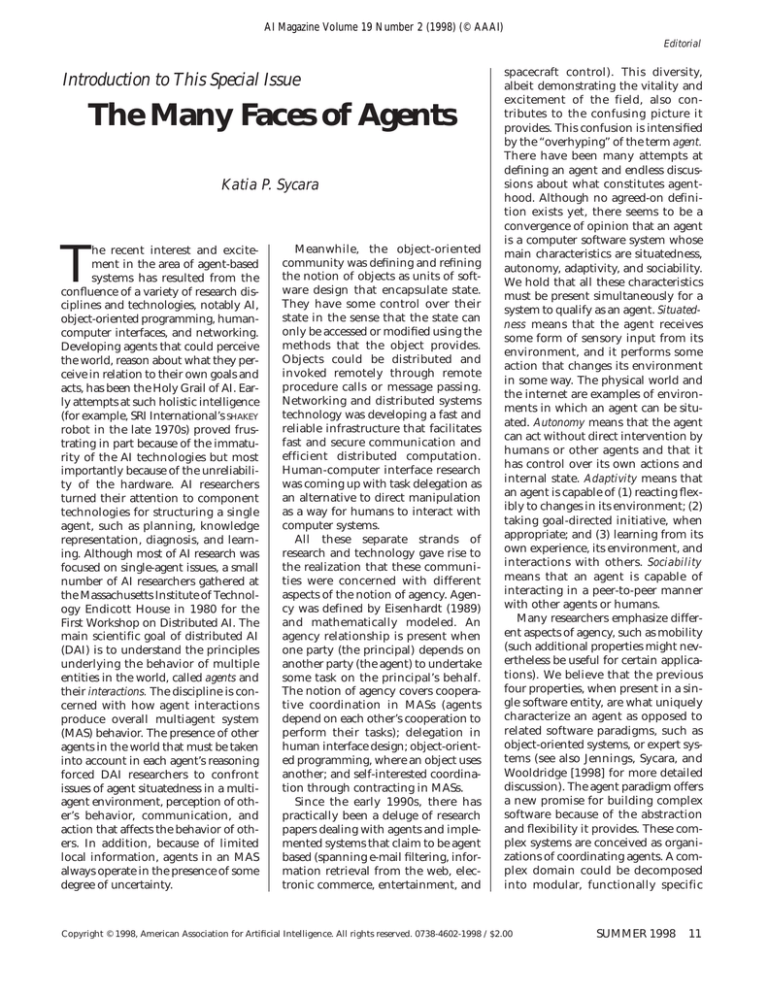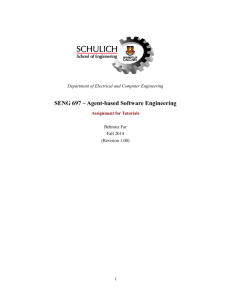
AI Magazine Volume 19 Number 2 (1998) (© AAAI)
Editorial
Introduction to This Special Issue
The Many Faces of Agents
Katia P. Sycara
T
he recent interest and excitement in the area of agent-based
systems has resulted from the
confluence of a variety of research disciplines and technologies, notably AI,
object-oriented programming, humancomputer interfaces, and networking.
Developing agents that could perceive
the world, reason about what they perceive in relation to their own goals and
acts, has been the Holy Grail of AI. Early attempts at such holistic intelligence
(for example, SRI International’s SHAKEY
robot in the late 1970s) proved frustrating in part because of the immaturity of the AI technologies but most
importantly because of the unreliability of the hardware. AI researchers
turned their attention to component
technologies for structuring a single
agent, such as planning, knowledge
representation, diagnosis, and learning. Although most of AI research was
focused on single-agent issues, a small
number of AI researchers gathered at
the Massachusetts Institute of Technology Endicott House in 1980 for the
First Workshop on Distributed AI. The
main scientific goal of distributed AI
(DAI) is to understand the principles
underlying the behavior of multiple
entities in the world, called agents and
their interactions. The discipline is concerned with how agent interactions
produce overall multiagent system
(MAS) behavior. The presence of other
agents in the world that must be taken
into account in each agent’s reasoning
forced DAI researchers to confront
issues of agent situatedness in a multiagent environment, perception of other’s behavior, communication, and
action that affects the behavior of others. In addition, because of limited
local information, agents in an MAS
always operate in the presence of some
degree of uncertainty.
Meanwhile, the object-oriented
community was defining and refining
the notion of objects as units of software design that encapsulate state.
They have some control over their
state in the sense that the state can
only be accessed or modified using the
methods that the object provides.
Objects could be distributed and
invoked remotely through remote
procedure calls or message passing.
Networking and distributed systems
technology was developing a fast and
reliable infrastructure that facilitates
fast and secure communication and
efficient distributed computation.
Human-computer interface research
was coming up with task delegation as
an alternative to direct manipulation
as a way for humans to interact with
computer systems.
All these separate strands of
research and technology gave rise to
the realization that these communities were concerned with different
aspects of the notion of agency. Agency was defined by Eisenhardt (1989)
and mathematically modeled. An
agency relationship is present when
one party (the principal) depends on
another party (the agent) to undertake
some task on the principal’s behalf.
The notion of agency covers cooperative coordination in MASs (agents
depend on each other’s cooperation to
perform their tasks); delegation in
human interface design; object-oriented programming, where an object uses
another; and self-interested coordination through contracting in MASs.
Since the early 1990s, there has
practically been a deluge of research
papers dealing with agents and implemented systems that claim to be agent
based (spanning e-mail filtering, information retrieval from the web, electronic commerce, entertainment, and
spacecraft control). This diversity,
albeit demonstrating the vitality and
excitement of the field, also contributes to the confusing picture it
provides. This confusion is intensified
by the “overhyping” of the term agent.
There have been many attempts at
defining an agent and endless discussions about what constitutes agenthood. Although no agreed-on definition exists yet, there seems to be a
convergence of opinion that an agent
is a computer software system whose
main characteristics are situatedness,
autonomy, adaptivity, and sociability.
We hold that all these characteristics
must be present simultaneously for a
system to qualify as an agent. Situatedness means that the agent receives
some form of sensory input from its
environment, and it performs some
action that changes its environment
in some way. The physical world and
the internet are examples of environments in which an agent can be situated. Autonomy means that the agent
can act without direct intervention by
humans or other agents and that it
has control over its own actions and
internal state. Adaptivity means that
an agent is capable of (1) reacting flexibly to changes in its environment; (2)
taking goal-directed initiative, when
appropriate; and (3) learning from its
own experience, its environment, and
interactions with others. Sociability
means that an agent is capable of
interacting in a peer-to-peer manner
with other agents or humans.
Many researchers emphasize different aspects of agency, such as mobility
(such additional properties might nevertheless be useful for certain applications). We believe that the previous
four properties, when present in a single software entity, are what uniquely
characterize an agent as opposed to
related software paradigms, such as
object-oriented systems, or expert systems (see also Jennings, Sycara, and
Wooldridge [1998] for more detailed
discussion). The agent paradigm offers
a new promise for building complex
software because of the abstraction
and flexibility it provides. These complex systems are conceived as organizations of coordinating agents. A complex domain could be decomposed
into modular, functionally specific
Copyright © 1998, American Association for Artificial Intelligence. All rights reserved. 0738-4602-1998 / $2.00
SUMMER 1998
11
Editorial
software components—agents. When
interdependencies arise, the agents
adaptively coordinate to handle them.
The agent-based view could offer a
powerful set of tools, techniques, and
metaphors that has the potential to
redefine the ways people interact with
and build software. This prospect is
exciting for us because it brings concepts and techniques developed by AI
researchers into the forefront of software development.
The Articles in This Issue
This issue brings together an eclectic
set of articles on topics that, in general, have not been in the mainstream of
AI.
The article by Clark Elliot and Jacek
Brzenzski surveys research issues and
approaches in building believable
agents that communicate and interact
with humans. Such software is especially attractive to humans because of
its redeeming social qualities that
enable humans to interact with agents
in entertaining and innovative ways.
The authors argue that these qualities
will not only facilitate creative applications, for example, in entertainment
and teaching, but also could elucidate
issues and provide useful insights in
the development of agent-based systems as such.
The article by Eaton, Freuder, and
Wallace explores the synergies between constraint-based reasoning and
agents and argues for increased interaction among the constraint research
community and the agent research
community so that productive crossfertilization of ideas and techniques
can ensue. Constraint-based agents are
suitable for solving a variety of interesting and practically significant problems that can be modeled as constraint satisfaction or constraint
optimization. These problems include
resource-allocation problems (where
only resource constraints must be taken into account); more complex
scheduling problems, such as job-shop
scheduling and meeting scheduling,
where both resource and temporal
constraints must be considered; configuration problems; and parametric
design. For such applications, agents
whose architecture is based on con-
12
AI MAGAZINE
straints are most effective; however,
constraint-based reasoning can be useful in agent-based systems to allow
agents to reason about available computational resource constraints (for
example, network bandwidth) or
reach agreeable compromises in negotiations over limited resources.
My article presents the basic motivations and research issues in MASs. It
surveys research in multiagent problem solving and coordination that has
its roots in the DAI community. Interactions based on cooperative, as well
as self-interested, agents are presented.
It is argued that as computer applications and research move increasingly
toward more dynamic and open environments, MASs will become the
dominant paradigm for software structuring. This development leads to a set
of open issues and future directions for
developing MASs.
The article by Michael Lewis critically presents the agent metaphor for
human-computer interaction. Interactions based on an agent metaphor
treat the computer as an intermediary
that responds to user requests. The
term agent has come to refer to the
automation of aspects of human-computer interaction, such as anticipating
commands or autonomously performing actions. Norman’s 1984 model of
human-computer interaction is introduced as reference to organize and
evaluate research in human-agent
interaction. A wide variety of heterogeneous research involving humanagent interaction is shown to reflect
automation of one stage of action or
evaluation within Norman’s model.
Improvements in human-agent interaction are expected to result from
more heterogeneous use of methods
that target multiple stages simultaneously.
The paper by Yoshiyasu Nishibe et
al. presents the experiences of the
Mobile Assistant Project that took
place during the Second International
Conference on Multiagent Systems
(ICMAS96) in Japan. The goal of the
project was to use mobile digital assistants to provide various types of electronic support for a large number of
diverse users in a real environment.
Each project participant was given a
personal digital assistant that had var-
ious services, such as sending and
receiving e-mail, finding conferencerelated information, and finding and
interacting with other participants.
Large amounts of data were collected
from the use of these services by participants in the Mobile Assistant Project during the five days of the conference. These data pertained to (1)
single-user information seeking and
the types of support that individual
conference participants used and (2)
the social interactions of participants.
Analysis of the data, conclusions
about the lessons learned regarding
the utility of the technology, and
design guidelines are presented in the
article.
Conclusions
Agent-based software systems offer the
promise of revolutionizing softwareengineering technology as they make
substantial progress toward the longheld goal of AI, namely, the development of holistic entities that interact
intelligently with their environment,
the users, and each other. What is currently lacking is (1) a coherent set of
problem-solving principles that can
profitably be combined to enable the
effective structuring of agents and
MASs; (2) the consolidation of techniques into a coherent and systematic
methodology that enables system
designers to define and structure their
applications in terms of agents; and
(3) a set of agent behaviors and
human-agent–interaction paradigms
that allow humans to interact naturally with agents, develop trust in them,
and ease the acceptance of agent technology. I hope that the articles in this
special issue have contributed toward
these goals. I would like to thank my
colleagues for contributing their articles to this issue.
References
Eisenhardt, K. 1989. Agency Theory: An
Assessment and Review. Academy of Management Review 14(1): 57–74.
Jennings, N.; Sycara, K.; and Wooldridge,
M. 1998. A Roadmap for Agent Research
and Development. Autonomous Agents and
Multiagent Systems 1(1). Forthcoming.


